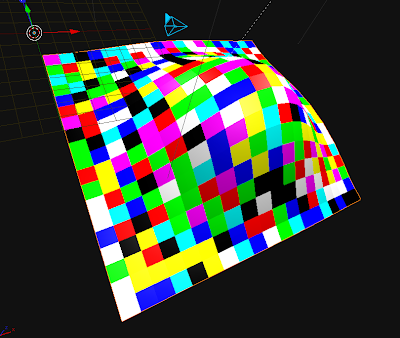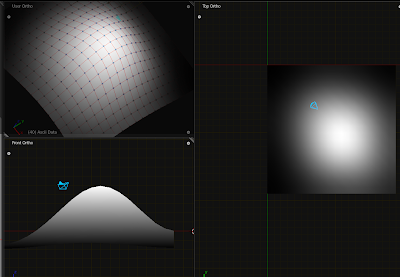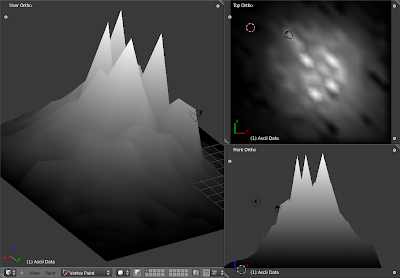Here is a link to updated version of this: update for 2.6x
below this point is outdated information
say you have just painted vertex colours in Vertex Paint mode.
>>> for i in bpy.context.active_object.data.vertex_colors[0].data:
# for every face print, color4 only useful in a Quad mesh.
... print(i.color1, i.color2, i.color3, i.color4)
will print layer 0 of Vertex Colors for that mesh object. This property is read/writeso you can manipulate the data according to (for example) their Z value.
# set everything to a midtone rgb Color((.5, .5, .5))
# modify vertex painted 'Vertex Colors' palette
import bpy
import random
from mathutils import Color
for i in bpy.context.active_object.data.vertex_colors[0].data:
i.color1 = Color((0.5, 0.5, 0.5))
i.color2 = Color((0.5, 0.5, 0.5))
i.color3 = Color((0.5, 0.5, 0.5))
i.color4 = Color((0.5, 0.5, 0.5))
this makes all colours utterly random ( super ugly! )
# modify vertex painted 'Vertex Colors' palette
import bpy
import random
from mathutils import Color
for i in bpy.context.active_object.data.vertex_colors[0].data:
r = random.randint(0,1)
g = random.randint(0,1)
b = random.randint(0,1)
VertCol = (r,g,b)
i.color1 = Color((VertCol))
i.color2 = Color((VertCol))
i.color3 = Color((VertCol))
i.color4 = Color((VertCol))

this checks their Z height and makes them lighter at heigher Z-values. First it checks the highest Z value and lowest Z value in the coordinate list for those Faces, then adjusts the Height-to-VertexColor function accordingly
This is much longer because it includes the remap function, which i'm sure could be done with one function call, like in actionscript or processing. EDIT: for an updated version of the remap function used below visit remap-with-input-error-checking
# modify vertex painted 'Vertex Colors' palette
import bpy
import random
from mathutils import Color, Vector
def remap(current, lower_old, upper_old, lower_new, upper_new):
# error spreads must return difference between the values
old_tup = lower_old, upper_old
new_tup = lower_new, upper_new
# reusing a nicely coded Vector math utility :)
old_min = Vector((0.0, 0.0, lower_old))
old_max = Vector((0.0, 0.0, upper_old))
new_min = Vector((0.0, 0.0, lower_new))
new_max = Vector((0.0, 0.0, upper_new))
# fast and saves room!
spread_old = (old_max-old_min).length
spread_new = (new_max-new_min).length
factor_remap = spread_new / spread_old
current_vector = Vector((0.0, 0.0, current))
remap_temp =(current_vector-old_min).length
remapped = (remap_temp * factor_remap) + new_min[2]
# i think color values are clamped by blender, but it is
# good practice to not take this for granted in all cases.
if remapped < lower_new: return lower_new
if remapped > upper_new: return upper_new
# value seems alright!
return remapped
# Find upper and lower z values.
# there are many ways to skin this cat, but i'm going to be lazy
z_list = []
for i in bpy.context.active_object.data.vertices:
z_list.append(i.co.z)
z_list = sorted(z_list)
print('lower z',z_list[0])
print('upper z',z_list[len(z_list)-1])
lower_old = z_list[0]
upper_old = z_list[len(z_list)-1]
lower_new = 0.0
upper_new = 1.0
vertlist = bpy.context.active_object.data.vertices
facelist = bpy.context.active_object.data.faces
colorlist = bpy.context.active_object.data.vertex_colors[0].data
for i in range(len(colorlist)):
remapped = []
for element in range(4):
vertnum1 = facelist[i].vertices[element]
remap_1 = vertlist[vertnum1].co.z
remap_1 = remap(remap_1, lower_old, upper_old, lower_new, upper_new)
remapped.append(Color((remap_1,remap_1,remap_1)))
colorlist[i].color1 = remapped[0]
colorlist[i].color2 = remapped[1]
colorlist[i].color3 = remapped[2]
colorlist[i].color4 = remapped[3]

